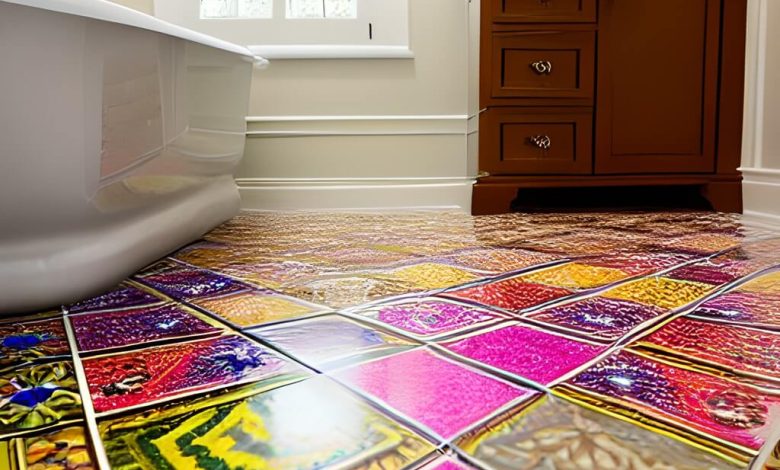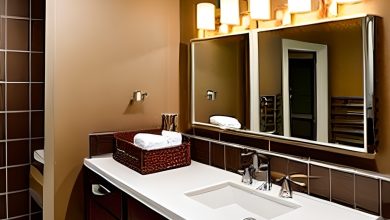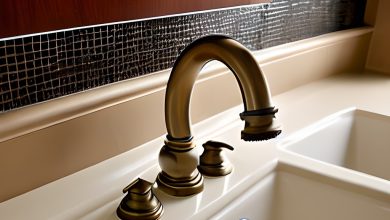How to Retile a Bathroom Floor: A Step-by-Step Guide

Retiling a bathroom floor is a great way to update the look of your space and make it look more modern. With the right tools and materials, it is a project that can be completed relatively quickly and easily. Here is a basic guide on how to retile a bathroom floor:
First, you will need to prepare the area. This includes removing any existing tile and cleaning the area thoroughly. Then, you will need to make sure that the walls and floor are even and smooth, as any uneven surfaces will affect the placement of the tiles. You may also need to apply a primer or waterproofing agent to the area before tiling.
Next, you will need to select and purchase your tiles. Take into account the size of the space as well as any existing fixtures or features when choosing your tiles. Once you have your tiles, you can begin installing them. Make sure to use spacers between each tile to ensure that they are even and secure. Once all of the tiles are placed, you can grout and seal them with a quality sealant.
Finally, let your tiles dry completely before returning fixtures or furniture to the area. This is an important step in ensuring that the tiles remain secure and in place while also protecting against water damage. With these steps completed, your new bathroom floor is ready for use! With a bit of patience and attention to detail, you can easily retile your bathroom floor and create a stunning and modern new look in your home.
Step-by-Step Guide to Retiling a Bathroom Floor
Retiling a bathroom floor is a project that can take several days to complete, depending on the size of your bathroom and the project’s scope. However, with some hard work and patience, you can transform your old floor into a fresh one. Following is a step-by-step guide to getting you started.
1. Clear out the bathroom – Before beginning any renovation project, the first step is always to empty the room and take everything off the walls. This includes removing any existing tiles or adhesive stuck to the subfloor.
2. Prepare the surface – After clearing the room, use a sander to flatten any high spots in the subfloor. Then, apply an adhesive, such as thin-set mortar, over the subfloor to ensure it’s even and secure.
3. Lay down the new tiles – After you’ve prepared and leveled the subfloor, begin laying down your new tiles, starting at the center and working your way outwards in a grid pattern. Make sure you leave enough space between each tile for grout lines.
4. Cut any necessary tiles – If any areas need custom tile cuts, such as around door frames or fixtures, use a wet saw to cut these pieces to fit.
5. Apply grout – Once all of your tiles are laid down, you can apply grout between each one. Make sure you don’t skimp on this step because it will ensure your tiles remain securely in place for years to come.
6. Seal the grout – After you’ve waited for the grout to dry thoroughly, use a sealant to protect it from moisture and staining.
7. Let the floor rest – Set it a day or two before walking on it or using fixtures in the bathroom. This will ensure that your hard work isn’t ruined by careless movement or use during this sensitive period.
With these steps in mind, you will be well on your way to completing a successful retiling job in your bathroom!
How to Choose the Right Tiles for a Bathroom Floor
Finding suitable tiles for a bathroom floor can be a challenge. It’s essential to find tiles that are not only aesthetically pleasing but also practical and long-lasting. Follow these tips to help choose the right tiles for your bathroom floor.
The first step is to consider the size of your bathroom. This will help you determine the best size and shape for your space’s tile. It is best to opt for small tiles in light colors for small bathrooms, as this will make the room appear larger. For larger bathrooms, larger tiles can create a more open feel.
The next step is to think about the style of tile you want. Porcelain and ceramic are the most popular choices for a bathroom floor, but many others are available, such as stone, glass, terracotta, and even wood. Think about what look you are trying to achieve and choose accordingly.
The next factor to consider is functionality. Think about how the tile will hold up under wet conditions, how easy it will be to clean and maintain, and if it will be slip-resistant. Make sure to choose tiles suitable for bathroom floors so they can stand up to heavy foot traffic and spills.
Finally, think about color and pattern. Tiles come in an array of shapes, sizes, colors, and patterns, so you can find something that perfectly suits your style and taste. Choose tiles that match your bathroom’s overall look or create a unique design feature.
With these tips in mind, you should be able to find the perfect tiles for your bathroom floor. Consider size, style, functionality, and color carefully when selecting so you can create a stylish and practical look.
What Tools Are Needed to Retile a Bathroom Floor?
Retiling a bathroom floor can be a daunting task, but with the right tools and supplies, the job can be done quickly and easily. Here are some of the essential tools you will need to retile a bathroom floor:
- Tape Measure: This is an essential tool for measuring the size of your bathroom floor and any other surfaces you need to work on.
- Tile Cutter: A tile cutter is an invaluable tool for cutting tiles to create straight lines, curves, or intricate designs.
- Tile Spacers: These spacers come in various sizes, depending on the size of your tiles. They help ensure that your tiles are spaced evenly and securely in place.
- Grout Float: A grout float presses the grout into the spaces between the tiles. It will also help create a smooth, professional finish.
- Trowel: A trowel spreads the adhesive or mortar evenly over the surface before laying down your tiles. It also helps to get rid of any air bubbles that can be trapped between the tiles and the surface.
- Rubber Mallet: A rubber mallet is used to press down your tiles to ensure they correctly adhere to the surface.
- Putty Knife: This tool scrapes up excess adhesive or mortar from the surface of your tiles.
- Caulking Gun: A caulking gun is used to apply sealant around the edges of your tiles, which will help prevent water damage, mold, and dirt from getting in between tiles.
- Safety Glasses and Gloves: Wearing safety glasses and gloves is essential to protect yourself from flying debris or chemicals that could cause injury.
Using these essential tools, you can easily and quickly retile your bathroom floor for a beautiful new look.
DIY Tips for Retiling a Bathroom Floor
Retiling a bathroom floor is a great DIY project but challenging. Here are some tips to make the job easier:
- Start by removing your existing tile. Wear safety glasses and use a hammer and chisel to tap and pry the tiles off gently. Work from the top corner down, and be careful not to damage the underlying layers.
- Once you have removed the old tiles, inspect the underlying layers for any damage. Ensure the surface is leveled, as uneven tiles can prevent the proper installation of your new tiles.
- After cleaning and prepping the floor, begin laying down a layer of thin-set mortar or adhesive, which serves as an adhesive for the new tiles. Use a notched trowel to spread the mortar evenly over the surface and follow the manufacturer’s instructions on the product packaging.
- Begin laying down your new tiles, beginning at one corner of the bathroom and working outward. Make sure to include spacers between each tile to allow for expansion and contraction with high humidity levels and proper grout lines.
- Once you have laid all your new tiles, you can grout them. Make sure to mix your grout according to the manufacturer’s instructions and apply it using a rubber float in a zig-zag pattern from one joint to another. After all, grouting is complete, allow it to cure for 24 hours before applying sealant.
- Finally, apply a sealant over the entire surface of your newly tiled floor, including grout lines and edges, to help protect against water damage and staining.
By following these steps, you can easily retile your bathroom floor!
Common Mistakes to Avoid When Retiling a Bathroom Floor
Retiling a bathroom floor is a great way to give your space an updated look. However, it is important to be aware of the common mistakes that can occur during the process. Here are some tips to help you avoid them:
1. Not Preparing the Surface – Before you start retiling, you need to clean and prepare the surface. This involves having a flat, level base so that the tiles will lay evenly when installed. If you don’t take the time to do this, you may end up with lippage, which is when tiles are not sitting at the same height as one another.
2. Not Measuring – Take accurate measurements before you begin your retiling project. This ensures that you buy the correct amount of tile for the space, preventing any wasted materials and money. Additionally, make sure you leave room for grout so that your end result is even and aesthetically pleasing.
3. Using the Wrong Mortar – Choosing a good quality mortar is essential as it can affect how well your tiles adhere to the surface and how long they stay in place over time. It’s important to select a mortar specific to your task and based on whether you are using ceramic or porcelain tiles, as different types require different adhesives.
4. Not Sealing Your Tiles – Many people forget that they need to seal their tile after it has been installed. This step helps protect and preserve your tile against staining and discoloration over time. Make sure you select an appropriate sealer for your particular tile type for best results.
Retiling a bathroom floor can be a fun DIY project, but it’s important to be aware of these common mistakes and take the necessary steps to avoid them. With careful preparation and consideration, you can ensure a successful outcome and enjoy your beautiful new bathroom floor for many years to come.
What Type of Grout Is Best for Retiling a Bathroom Floor?
Retiling a bathroom floor can drastically improve your space’s look, but choosing the right type of grout is essential. Grout is a cement-based material that provides a seal between tiles, and it’s available in sanded and unsanded varieties. Both types offer excellent durability and flexibility but sanded grout is generally the better option when tiling a bathroom floor.
Sanded grout is composed of cement, water, and sand, which provides greater strength for large-scale flooring projects. The gritty texture also helps to fill small gaps between tiles, creating a uniform surface. Unlike unsanded grout, sanded grout requires less precision when applying it to your bathroom floor.
In comparison, unsanded grout mainly comprises cement and water, making it best suited for smaller projects where precision is critical. It’s highly adhesive, so it helps create an even surface on walls or countertops with narrow grout lines. However, without sand particles mixed into the mixture, unsanded grout can be weaker and less durable than its sanded counterpart.
Both sanded and unsanded grouts come in various colors and can be used along with various types of tile. When retiling your bathroom floor, sanded grout is likely your best option. It will provide more strength and flexibility than the unsanded variety, helping to keep your bathroom floor looking great for years to come.
Cost Considerations for Retiling a Bathroom Floor
Cost considerations for retiling a bathroom floor can be complicated and expensive. Many homeowners choose to DIY; however, even with the help of YouTube tutorials and Home Depot classes, it can be a challenging home improvement project. Professionally installed tiles sets come with various prices, but many factors can increase the cost.
Materials are one of the most significant cost considerations when retiling a bathroom floor. The type of tile you choose — ceramic, stone, marble, or something more exotic — will significantly impact the final price. Additionally, the amount of labor involved will add to the total cost. If you hire a contractor for installation, the cost will be higher than if you do it yourself.
Location is another primary cost consideration when retiling a bathroom floor. This will affect the overall price tag if you’re in an area with high labor costs. If you’re tiling in an area with limited access, such as a small space behind a toilet, this will also increase the cost due to the added difficulty.
Subflooring is also an important cost consideration. In some cases, it may be necessary to replace the existing subflooring, which can significantly increase the cost of retiling. Additionally, any repairs that need to be made to the walls or existing tile should be considered before you begin pricing out materials and labor.
Finally, the cost of fixtures and accessories should be considered when budgeting for retiling a bathroom floor. This includes oomph pads and trim pieces, which can add up quickly if you install them yourself. If these items are included in your tile set and installed by a professional, they may not factor into the overall price.
These are just some of the many cost considerations for retiling a bathroom floor. Whether you are doing it yourself or hiring a professional, it is essential to build in extra costs for any unexpected costs that may arise during the project. With careful planning and budgeting, you can get a beautiful new floor that has looked amazing for many years.
Pros and Cons of Different Tiles for Retiling a Bathroom Floor
Retiling a bathroom floor is an exciting process but can be overwhelming with so many choices of tiles available. There are several different types of tiles that you can choose from, each with its advantages and disadvantages.
Ceramic tiles are one of the most popular choices for retiling a bathroom floor. They are an affordable option and come in various colors and designs. Ceramic tile is also easy to maintain because they are moisture-resistant and durable. However, they can be slippery when wet, so you may opt for textured or non-slip tile if you have it in your bathroom.
Porcelain tile is another popular choice for retiling a bathroom floor. It is much more durable than ceramic tile and waterproof, making it ideal for wet areas like bathrooms. Porcelain tile is also available in various colors and designs and can be made to look like natural stone or wood. The downside of porcelain tile is that it can be expensive and require professional installation.
Stone tile is also an excellent option for retiling a bathroom floor. Natural stone tiles are beautiful and come in various shapes and sizes. They are also very durable and will last longer than other tiles. The downside is that stone tiles can be expensive and require professional installation.
Glass tile is another excellent option for retiling a bathroom floor. Glass tiles add a unique look to any room and come in many colors and styles. They are also moisture-resistant and easy to clean, making them perfect for bathrooms with a lot of use. The downside is that glass tiles can be expensive and require professional installation.
These are just some of the pros and cons associated with different types of tiles for retiling a bathroom floor. Consider your budget, style preference, and maintenance needs when selecting the right tile for your project. Ultimately, the perfect tile choice will depend on your personal preference and needs!
Conclusion
If you need to retile your bathroom floor, follow the steps below. First, you should remove any existing tiles. This may require chiseling off old tiles, which can be labor-intensive. Once the removal is complete, clean any dust or debris from the floor. Next, you will need to apply a waterproofing membrane and then lay down the thin-set mortar. Once that is done, start laying your tiles in the desired pattern. Finally, apply grout between each tile to ensure a secure fit and finish.
Taking on a project like retiling a bathroom floor can initially seem intimidating. But if you break it down into these individual steps and take your time, it can be an easily manageable do-it-yourself job. Before starting, ensure you are appropriately prepared with the right tools, materials, and instructions. With proper preparation and following these steps, anyone can have a beautiful new bathroom floor in no time!
Finally, if you are still hesitant about taking on a project like this, it might be best to contact a professional for help. They can offer guidance and support throughout the project, ensuring it is done correctly and safely. Retiling a bathroom floor with the right help and guidance will be a much more successful and satisfying experience than tackling it alone.




